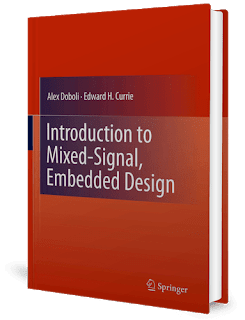| Book Name: | [PDF] Introduction to Mixed-Signal, Embedded Design by Alex, Edward |
| Free Download: | Available |
Introduction to Mixed-Signal, Embedded Design by Alex, Edward ::
Book Content:
1 An Overview of Mixed-Signal, Embedded System Design
1.1 Embedded Applications
1.2 Embedded Architectures
1.3 Top-Down Design Flow
1.4 Embedded Systems Market
1.5 Embedded Design Example: Fan Control System
1.5.1 Description of the Fan Controller System
1.5.2 Design of the Fan Controller System
1.6 Conclusions
1.7 Further Readings
1.8 Recommended Exercises
2 Microcontroller Architecture
2.1 Microcontroller Architecture
2.1.1 Microcontroller Addressing Modes
2.1.2 Instruction Set
2.2 Memory Space
2.3 Conclusions
2.4 Recommended Exercises
3 Hardware and Software Subsystems of Mixed-Signal Architectures
3.1 Subsystems of the PSoC Mixed-Signal Architecture
3.1.1 PSoC Hardware Components
3.1.2 PSoC Software Components
3.2 The PSoC Interrupt Subsystem
3.2.1 Case Study: Tachometer Interrupt Service Routines
3.3 Global I/O Ports
3.4 SystemBuses
3.5 SystemClocks
3.6 Conclusions
3.7 Recommended Exercises
4 Performance Improvement by Customization
4.1 Introduction to Application-Specific Customization
4.2 Design Methodology for Architecture Customization
4.2.1 System Specification and Profiling
4.2.2 System Partitioning and Implementation
4.3 Programmable Digital Blocks
4.3.1 Timer Block
4.3.2 Counter Block
4.3.3 Deadband Block
4.4 Customized PSoC Digital Blocks
4.4.1 Pulse Width Modulator Blocks
4.4.2 Multiply ACcumulate
4.4.3 Decimator Blocks
4.5 Conclusions
4.6 Recommended Exercises
5 Programmable Data Communication Blocks
5.1 Abstract Communication Channels
5.2 Channel Implementation Units
5.3 Hardware–Software Implementation of Channels
5.4 Channel Implementation Unit: SPI Block
5.4.1 Hardware Circuit
5.4.2 Software Routines
5.5 Channel Implementation Unit: UART Block
5.5.1 UART Hardware Circuit
5.5.2 Software Routines
5.6 Conclusions
5.7 Recommended Exercises
6 Continuous-Time, Analog Building Blocks
6.1 Introduction to Operational Amplifiers
6.1.1 Ideal OpAmps
6.1.2 Real OpAmps
6.1.3 OpAmp Macromodeling
6.2 Continuous-Time Analog Building Blocks
6.2.1 Inverting Amplifiers
6.2.2 Non-Inverting Amplifier
6.2.3 Summing Amplifier
6.2.4 Difference Amplifier
6.2.5 Integrator
6.2.6 Comparator
6.3 Reconfigurable Continuous-Time Analog Blocks
6.4 Conclusions
6.5 Recommended Exercises
7 Switched-Capacitor Blocks
7.1 Introduction To Switched Capacitor Techniques
7.1.1 Nonidealities in Switched Capacitor Circuits
7.2 Active Switched Capacitor Circuits
7.2.1 Fixed Gain Amplifier
7.2.2 Comparators
7.2.3 Switched Capacitor Integrator
7.2.4 Switched Capacitor Differentiator
7.2.5 Reference Selection
7.2.6 Analog-to-Digital Conversion
7.3 Switched Capacitor PSoC Blocks
7.3.1 Type C Switched Capacitor Blocks
7.3.2 Type D Switched Capacitor Blocks
7.4 Conclusions
7.5 Recommended Exercises
8 Analog and Digital Filters
8.1 Filter Fundamentals
8.1.1 Passive Filters
8.1.2 Linear Active Filters
8.1.3 Digital Filters
8.1.4 Filter Components
8.2 Filter Design
8.2.1 Specific Filter Types
8.2.2 Filter Parameters
8.2.3 Scaling and Normalization
8.2.4 Cascading Analog Filters
8.3 Analog Filters
8.3.1 Time-Continuous Integrators as Filters
8.3.2 The Passive Lowpass Filter
8.3.3 The Sallen–Key Lowpass Active Filter
8.3.4 The Switched-Capacitance Filter
8.3.5 Biquad Switched Capacitor Filter
8.3.6 An Allpass Filter
8.4 Digital Filters
8.4.1 Digital FIR Filter
8.4.2 Infinite Impulse Response Filter
8.5 Filter Design Software Tools
8.6 Conclusion
8.7 Recommended Exercises
9 Analog-to-Digital Converters
9.1 Nyquist ADCs-A Short Introduction
9.1.1 Sampling and Quantization
9.1.2 Sampling
9.1.3 Quantization
9.2 ADCs
9.2.1 Oversampling and Noise-Shaping
9.2.2 ADC Performance
9.2.3 First-Order Modulator
9.2.4 PSoC Implementation of First-Order Modulators
9.2.5 Impact of Circuit Non-Idealities on Modulator Performance
9.2.6 Second-Order Modulator
9.3 Conclusions
10 Future Directions in Mixed-Signal Design Automation
10.1 Top-Down Design and Design Activities
10.2 Two Examples of Architecture Customization
10.2.1 IDEA Algorithm for Data Encryption
10.2.2 Face Detection for Image Processing
10.3 Challenges in Mixed-Signal Design Automation
10.3.1 High-Level Specification of Analog and Mixed-Signal Systems
10.3.2 Fast Performance Estimation by Customized Simulation Code
10.3.3 High-Level Synthesis of Analog Subsystems
Introduction to Mixed-Signal, Embedded Design by Alex, Edward

Introduction to Mixed-Signal, Embedded Design
Author(s): Alex Doboli, Edward H. Currie
Publisher: Springer, Year: 2011
ISBN: 1441974458
Edition : N/A
Length : 472 pages
Size : 5 MB
Language: English
[PDF] Introduction to Mixed-Signal, Embedded Design by Alex, Edward Table Of Contents
Front Matter….Pages i-xxiii
An Overview of Mixed-Signal, Embedded System Design….Pages 1-49
Microcontroller Architecture….Pages 51-102
Hardware and Software Subsystems of Mixed-Signal Architectures….Pages 103-150
Performance Improvement by Customization….Pages 151-206
Programmable Data Communication Blocks….Pages 207-242
Continuous-Time, Analog Building Blocks….Pages 243-288
Switched-Capacitor Blocks….Pages 289-324
Analog and Digital Filters….Pages 325-371
ΔΣ Analog-to-Digital Converters….Pages 373-411
Future Directions in Mixed-Signal Design Automation….Pages 413-441
Back Matter….Pages 443-452
Related More Books
Thanks For Visiting Our Website https://www.freepdfbook.com To Support Us, Keep Share On Social Media.









![[PDF] Draw Buildings and Cities in 15 Minutes Draw Buildings and Cities in 15 Minutes pdf](https://www.freepdfbook.com/wp-content/uploads/2021/06/Draw-Buildings-and-Cities-in-15-Minutes-218x150.jpg)








![[PDF] Digital Image Processing An Algorithmic Introduction Using Java Digital Image Processing An Algorithmic Introduction Using Java](https://www.freepdfbook.com/wp-content/uploads/2022/06/Digital-Image-Processing-An-Algorithmic-Introduction-Using-Java.jpg)




![[PDF] 43 Years JEE ADVANCED + JEE MAIN Chapterwise & Topicwise Solved Papers 43 Years JEE ADVANCED (1978-2020) + JEE MAIN Chapterwise & Topicwise Solved Papers Physics PDF](https://www.freepdfbook.com/wp-content/uploads/2022/03/43-Years-JEE-ADVANCED-1978-2020.jpg)

![[PDF] Problems in Physical Chemistry for JEE (Main & Advanced) Problems in Physical Chemistry for JEE (Main & Advanced) Free PDF Book Download](https://www.freepdfbook.com/wp-content/uploads/2022/03/Problems-in-Physical-Chemistry-for-JEE-Main-Advanced.jpg)
![[PDF] Engineering Physics (McGraw Hill)](https://www.freepdfbook.com/wp-content/uploads/2021/05/bafc8c2685bb6823a9c56134f7fba5df.jpeg)

![[PDF] Engineering Chemistry By Shashi Chawla](https://www.freepdfbook.com/wp-content/uploads/2022/05/Theory-And-Practicals-of-Engineering-Chemistry-By-Shashi-Chawla-free-pdf-book.jpeg)
![[PDF] Chemistry: An Introduction to Organic, Inorganic & Physical Chemistry Chemistry: An Introduction to Organic, Inorganic & Physical Chemistry](https://www.freepdfbook.com/wp-content/uploads/2022/04/Chemistry-An-Introduction-to-Organic-Inorganic-Physical-Chemistry.jpg)
![[PDF] Essentials of Physical Chemistry Essentials of Physical Chemistry Free PDF Book by Bahl](https://www.freepdfbook.com/wp-content/uploads/2022/04/Essentials-of-Physical-Chemistry-bahl.jpg)
![[PDF] Biological control of plant-parasitic nematodes: soil ecosystem management in sustainable agriculture Biological control of plant-parasitic nematodes: soil ecosystem management in sustainable agriculture](https://www.freepdfbook.com/wp-content/uploads/2022/05/Biological-control-of-plant-parasitic-nematodes-soil-ecosystem-management-in-sustainable-agriculture.jpg)
![[PDF] Human Anatomy: Color Atlas and Textbook Human Anatomy: Color Atlas and Textbook Free PDF Book](https://www.freepdfbook.com/wp-content/uploads/2022/05/Human-Anatomy-Color-Atlas-and-Textbook.jpg)
![[PDF] Concepts of Biology Book [Free Download]](https://www.freepdfbook.com/wp-content/uploads/2022/05/Concepts-of-Biology.jpg)
![[PDF] Essentials of Biology [Free Download] Essentials of Biology Free PDF BOok Download](https://www.freepdfbook.com/wp-content/uploads/2022/05/Essentials-of-Biology-Free-PDF-Book-Downlaod.jpg)
![[PDF] Human Biology Book [Free Download]](https://www.freepdfbook.com/wp-content/uploads/2022/05/PDF-Human-Biology-Book-Free-Download.jpg)